Stakeholder Management Plan Template
 |
||
 |
||
This stakeholder management plan template will enable you to identify and categorize your stakeholders in terms of their 'interest'. The level of interest for each stakeholder is defined by assessing three key facets as they relate to that individual and the project:
1) Level of influence
2) Level of interest
3) Level of involvement
Thus allowing you to develop a comprehensive management strategy that ensures you set expectations appropriately and retain their support throughout the project life cycle according to their ability to affect the project and its outcome.
![]()
![]()
A stakeholder of a project can come in many forms and as such needs to be managed according to the impact they can exert on the project from inception to completion. As a project manager you need to have a thorough understanding of each of your stakeholders so that you can identify the most appropriate management strategy to effectively engage each stakeholder. You also need to ensure that your interactions with them fit their level of interest and influence over your project.
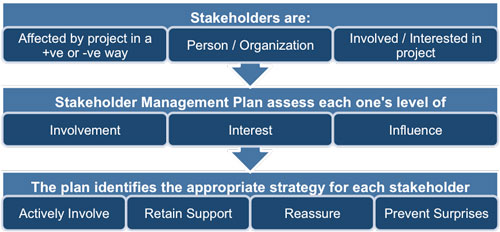 |
Very early in the life of a project, it is critical to identify all of the organizations and people who may have an impact on the project, and all those who may be impacted by it. A 'stakeholder' is any person or organization that is actively involved in a project, or whose interests may be affected positively or negatively by execution of a project.
A project manager must be sure to identify and list all potential stakeholders for a project. In addition to those on the project team potential stakeholders include:
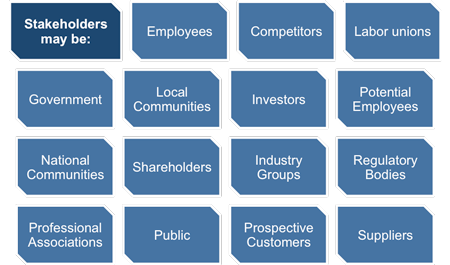 |
Stakeholders can be internal to the organization or external. In many projects the public at large will become a stakeholder to be considered during the project. The challenge for the project manager when the public is a stakeholder will be to act while considering public needs. Often there is no direct representative of the public to be consulted during project planning and execution.
Stakeholder involvement should be supported by an emphasis on quality relationships in which the parties are aware of their responsibilities, and where communication between them is clear and comprehensive. Stakeholder-based contributions to project success include executive support and effective use of the organization's infrastructure to support the project.
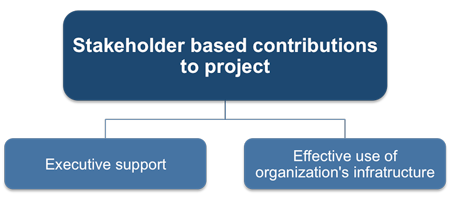 |
The project manager must document relevant information for all identified stakeholders. This information may include the stakeholder's interests, involvement, expectations, importance, influence, and impact on the project's execution as well as any specific communications requirements.
It is important to note that although some identified stakeholders may not actually require any communications they should still be identified. Once all have been identified then a plan for managing and controlling the project stakeholders can be produced.
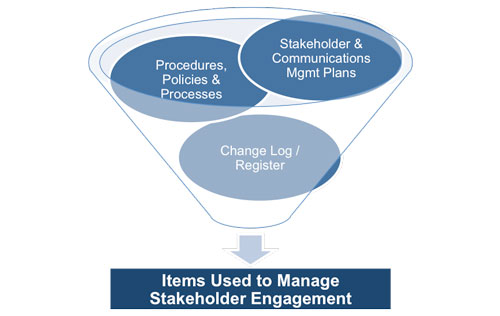 |
There are two main questions a project manager must ask; firstly, how to keep stakeholder engaged with the project? Secondly, to what extent should they be involved? These answers will enable you to assign an appropriate level for each of these activities. It is essential that as project manger you address issues that affect their interest in an expedient way and that the project continues to meet the stakeholder's needs.
By its very nature this plan will be closely linked to the communications management plan. It is within this plan that the level and nature of communication will be defined for each stakeholder. Such communications will contain sufficient information so that the interests of each stakeholder are met.
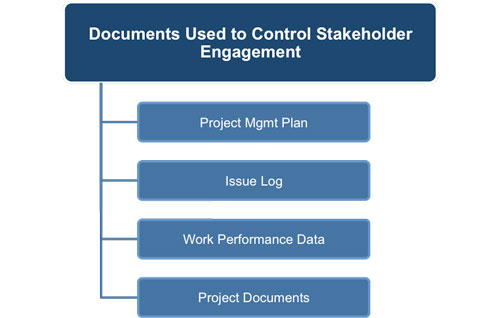 |
Projects exist in an interactive environment that is impacted by external forces that it can do its best to anticipate but inevitably some issues are difficult to predict and as such changes need to considered and made in order for the project to meet its end user requirements. That is why stakeholders need to be kept informed of additions to the change log or register as they occur so that they can assess its impact on their own interests and feedback their thoughts as part of the decision making process.
To manage stakeholders effectively a project manger must have excellent communications skills and a high level of emotional intelligence to be able to develop good working relationships and display the necessary empathy to retain individual's support and respect. There are several tools that project managers use to effectively control stakeholder engagement.
• Information management systems
• Meetings and
• Expert judgment.
Defining who and which meetings individual stakeholders should attend plays a critical role in a project managers ability to ensure the interactions with stakeholders is conducive to the overall project plan. With the support and backing of key stakeholders you will be able to keep your project on track and use these individuals to help you win the support of the other stakeholders.
The importance of planning and preparing a sound strategy to manage your stakeholders as early as possible in the project management process cannot be over emphasized. Good management of stakeholder's interests from the outset will help you to avoid unnecessary diversions that arise from a lack of understanding of their needs and interests.


